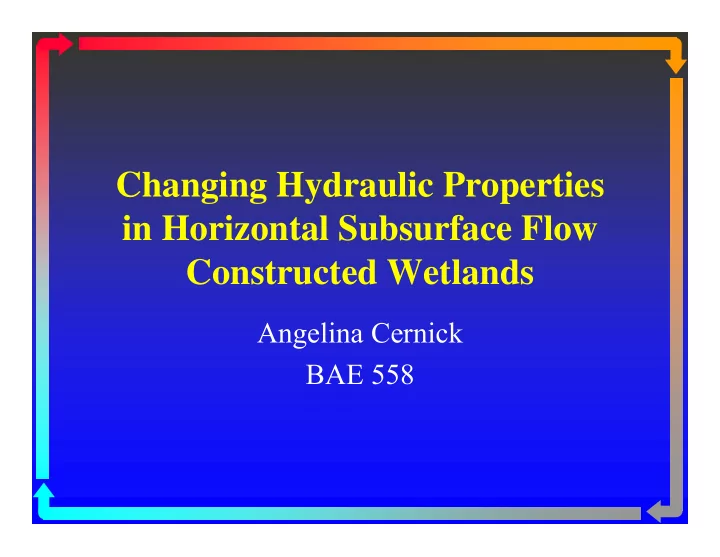

Ch Changing Hydraulic Properties i H d li P i in Horizontal Subsurface Flow Constructed Wetlands Angelina Cernick BAE 558 BAE 558
Introduction Introduction • Constructed wetlands can be part of a system Constructed wetlands can be part of a system to treat stormwater and wastewater • Contaminants such as nitrogen, phosphorus, heavy metals, bacteria and sediment h l b i d di • The flow through wetland soils plays important role in removing contaminants p g
Purpose Purpose • How does sedimentation affect hydraulic How does sedimentation affect hydraulic conductivity? • How does biological growth affect hydraulic • How does biological growth affect hydraulic conductivity? • And does all this affect the efficiency of the A d d ll hi ff h ffi i f h wetland?
Theory Theory • Removal efficiency requires controlled water Removal efficiency requires controlled water flow • Overtime soils clogs due to solids and bi l biological growth i l h • Solids and biological growth may change hydraulic conductivity y y
Darcy’s Law Guiding Equation q = -K( θ ) ▼ H q ( ) K = Cr 2 (L/L e ) 2 K = Cr 2 (L/L ) 2 D Darcy’s law could be function of sediment and ’ l ld b f ti f di t d biological growth, because K is essentially a f nction of radi s and L function of radius and L e
Sedimentation Sedimentation • Sedimentation is the process in which solids Sedimentation is the process in which solids are removed from the water column • Solids settle and/or attach to vegetation and • Solids settle and/or attach to vegetation and soil • Particle adsorbed to solids have varying P i l d b d lid h i properties that may affect conductivity
Clogging Due to Sedimentation Clogging Due to Sedimentation • Decrease in pore radius Decrease in pore radius • Increase in L Increase in L e • Leads to decrease in K • Leads to decrease in K K = Cr 2 (L/L e ) 2 ( e )
Biofilm Biofilm • A biofilm is a community of microorganisms A biofilm is a community of microorganisms within a self-developed polymeric matrix and adherent to a surface adherent to a surface. • Biofilms are also often characterized by Bi fil l f h i d b surface attachment, complex community interactions, and an extracellular matrix of i i d ll l i f polymeric substances. • Wikipedia Wiki di
Bioclogging Bioclogging • Results from the growth Results from the growth of biofilm • The aging of a biofilm causes a decrease in void space K = Cr 2 (L/L e ) 2
Results of Sedimentation Results of Sedimentation • Sediment Load Sediment Load • Hydraulic Conductivity Hydraulic Conductivity • Kg per square meter • Meters a day Figures from Caselles-Osorio et al.
Results of Bioclogging Hydraulic Conductivity Tables from Suliman et al.
Results of Bioclogging Other Parameters • Change seen in • Change seen in • Retention time • Dispersivity • Pore water velocity Tables from Suliman et al.
Conclusion: Sedimentation Conclusion: Sedimentation In the study, no wetlands lost pollutant removal In the study, no wetlands lost pollutant removal efficiency over time “The main consequence of solids accumulation in SSF CWs is a reduction in either the in SSF CWs is a reduction in either the hydraulic retention time and the hydraulic conductivity (K)” (Caselles-Osorio et al). y ( ) ( ) Be careful of too high pollutant load Be careful of too high pollutant load
Conclusion: Bioclogging Conclusion: Bioclogging In SS, clogging increases pore velocity and decreases In SS, clogging increases pore velocity and decreases retention time and may decrease efficiency. “Soils or filter materials with d 10 between 0.3 and 1.0mm are suitable for intermittent wastewater loading, while a d 10 between 1 and 1.5mm are suitable for long operation without resting.” (F. Suliman et al). li l) In LWA, clogging increases retention time and hence improves the system treatment efficiency
Are there any Questions? Are there any Questions?
Recommend
More recommend